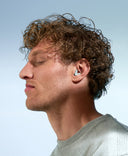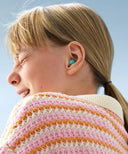The tapping of fingers on a keyboard. Someone chewing gum. A dripping tap. For most people, these are nothing more than background noise they hardly notice. But if you have misophonia, everyday sounds like these can feel unbearable. What is misophonia and what are its symptoms? What sounds are common triggers, and why do they cause such intense reactions? And what can you do if you live with misophonia?
What is misophonia?
Misophonia is a disorder where certain sounds trigger intense emotional, physical, or behavioral responses that others may view as unreasonable or extreme. The word "misophonia" comes from the Greek misos ("hate") and phónè ("sound"), literally meaning "hatred of sound." Some refer to it as noise anxiety, although selective noise sensitivity syndrome would be a more accurate description. This is because it involves reduced noise tolerance, but only to specific sounds.
The disorder is often compared to turning on a radio without realizing the volume is at maximum. You react impulsively or instinctively to the sudden blast and quickly turn it down. In misophonia, "trigger sounds" can instantly activate a fight-or-flight response, leading to emotional, physical, or behavioral reactions.
Symptoms of misophonia
Symptoms typically appear only when someone is triggered, and they can range from mild to severe.
Emotional reactions
These are intense, overwhelming feelings when you encounter a trigger. Examples include:
-
Uneasiness
-
Annoyance
-
Anxiety
-
Disgust
-
Anger
-
Panic
An emotional reaction can quickly escalate - for example, mild irritation might turn into anger.
Physical reactions
These are automatic bodily responses similar to what happens in dangerous situations (the fight/flight/freeze response). Examples include:
-
An increased heart rate
-
Higher blood pressure
-
Sweating
-
Pressure on the chest
-
Goosebumps
-
Muscle tension
Behavioral reactions
Behavioral responses are often impulsive and outside of your control. Examples include:
-
Avoiding situations where triggers might occur
-
Leaving the room when triggered
-
Taking action to stop the sound (for example, removing the battery from a ticking clock)
-
Verbal reactions
-
Violent responses (rare)
Triggers and examples of aversion to sounds
Trigger sounds can vary widely from person to person. Usually, they’re everyday, neutral sounds, often at low volume. Many people with misophonia are especially sensitive to sounds made by others. Common triggers include oral sounds such as:
-
Biting (like into an apple)
-
Chewing
-
Swallowing or slurping
-
Breathing
-
Yawning
-
Coughing or throat clearing
-
Sneezing
-
Clearing the nose
-
Snoring
-
Kissing
Other triggers might include:
-
Typing on a keyboard
-
Clicking a pen
-
Walking noises (especially in heels)
-
Scratching
-
Nail biting
-
Repetitive movements
-
Clock ticking
-
Dripping water
-
Cutlery sounds
-
Rustling
-
Birdsong
-
Windshield wipers
Many people with misophonia also respond to visual triggers, such as tapping fingers. If you react only to seeing specific repetitive movements, it's known as misokinesia ("hatred of movement").
Causes and origins of misophonia
Symptoms of misophonia can present at any age, but usually begin between the ages of 9 and 13. Misophonia seems to be more common in girls. Because there is nothing wrong with the hearing itself, people with misophonia are often not correctly diagnosed until a later stage. Sometimes the symptoms of misophonia are mistaken for an anxiety disorder or obsessive-compulsive disorder. But what causes misophonia? That is still being researched. In any case, we already know that the cause is not related to your ears. Presumably, misophonia is caused by a combination of factors:
-
Brain structure
Misophonia seems to be linked to how the brain filters and processes sensory information. Studies suggest disruptions in the brain’s connectivity between sound-processing areas and the regions responsible for emotional regulation (fight/flight/freeze responses). It’s also more common among neurodivergent individuals (such as those with ADHD or autism), suggesting that brain differences may contribute.
-
Intelligence and creativity
As early as the 19th century, philosopher Arthur Schopenhauer (1788 – 1860) connected sound intolerance with higher intelligence and creativity. Modern research, like studies from Northwestern University, supports the idea that creative individuals may struggle more with filtering out "irrelevant" sensory input.
-
Childhood conditioning
Many people trace their first symptoms back to childhood, often linked to family mealtimes and the sounds of others eating. This supports the idea that repeated exposure during key developmental stages may contribute to misophonia. However, more scientific evidence is needed to confirm this.
Effects of misophonia
Misophonia can make everyday activities challenging.
Paying attention during an interesting lecture becomes tough if a classmate keeps clicking their pen.
A fun dinner party can turn into a nightmare if another guest chews with their mouth open - while you struggle with anxiety over eating noises.
And snoring - if it’s a trigger - can put a serious strain on a romantic relationship.
These are just a few examples of how the disorder can affect your life.
Many people with misophonia develop anticipatory anxiety about situations where triggers might be present. This can lead to avoidance behaviors and social isolation. Lack of understanding by others can also result in conflict. The disorder can therefore seriously interfere with family, professional and social relationships.
What can you do if you have misophonia?
While misophonia can be tough to live with, there are ways to manage it. Here are some tips:
-
Wear hearing protection
Purchase good earplugs or earmuffs and make sure you always have them with you so you can protect yourself from trigger noises. Alpine hearing protection for concentration not only helps to maintain focus, but also provides relief from misophonia. Do you suffer from triggers especially in the evening or at night, such as from a snoring partner? Take a look at our earplugs for sleep.
-
Limit stress
Misophonia symptoms often worsen when you're stressed. Although stress isn’t always avoidable, you can manage it better with healthy habits: regular exercise, a nutritious diet, and good sleep. Techniques like deep breathing and progressive muscle relaxation can also help.
-
Seek professional help
Seeing a specialist is highly recommended. Misophonia is often treatable with a multidisciplinary approach. Cognitive Behavioral Therapy (CBT) has proven effective, helping people understand their reactions and develop coping strategies. Dialectical behaviour therapy (DBT) focuses on dealing with emotions through techniques such as mindfulness, emotional regulation and development of stress tolerance. In some cases, Tinnitus Retraining Therapy (TRT) has also been found to work well for misophonia; this involves learning to tolerate trigger sounds so they don't affect you as much. People who are frequently or quickly triggered can try a white noise device; this produces sounds designed to distract from triggers and reduce reactions.
-
Share your experiences with other misophonia patients
Feeling isolated? You’re not alone. A 2023 study found that about 18.4% of people in the United Kingdom live with misophonia - nearly 1 in 5! Of course, not everyone suffers equally, but there are numerous online communities where people with misophonia share their experiences and support each other.
-
Talk about it with those closest to you
It’s important to open up to close family and friends about your misophonia. Share your experiences and explain your triggers. A little understanding from loved ones can go a long way toward reducing conflict and making daily life easier.
This article is for informational purposes only and does not replace medical advice. Have questions about your health? Contact a doctor or healthcare provider.




